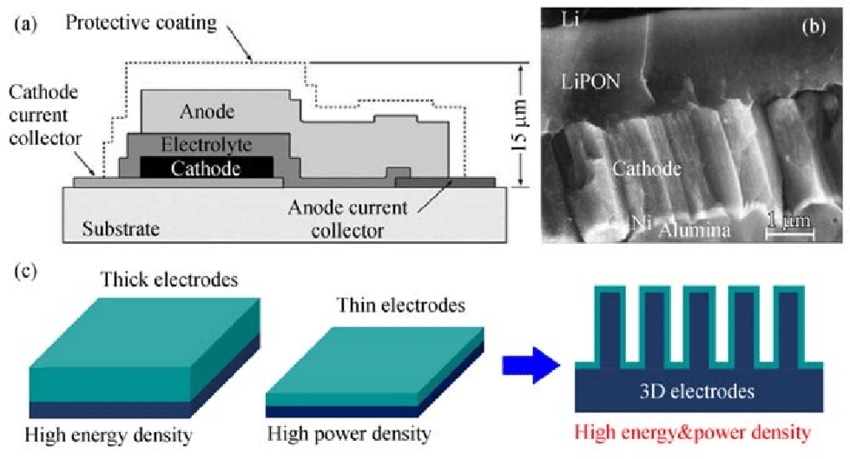Picosun Group, the provider of AGILE ALD® (Atomic Layer Deposition) thin film coating technology for global industries, reports excellent results achieved with ALD in the manufacturing of lithium ion thin film battery materials.
 Diagram of a conventional 2D all-solid-state thin-film Li-ion battery structure (a), its SEM section view (b), and advantages of the 3D battery structure. Image Source: Yue et. al., Fabrication of Si-based three-dimensional microbatteries: A review, in Frontiers of Mechanical Engineering 2017 (doi: 10.1007/s11465-017-0462-x).
Diagram of a conventional 2D all-solid-state thin-film Li-ion battery structure (a), its SEM section view (b), and advantages of the 3D battery structure. Image Source: Yue et. al., Fabrication of Si-based three-dimensional microbatteries: A review, in Frontiers of Mechanical Engineering 2017 (doi: 10.1007/s11465-017-0462-x).
Solid-state Li-ion thin film batteries (SSLIBs) are small, compact and may have flexible construction. They don’t contain any aggressive liquid substances, so they are safe to use. Furthermore, SSLIBs possess excellent energy storage capacity, which is why they are regarded as ideal power sources for electric cars, laptops, tablets and smartphones, wireless sensors, implantable and wearable medical devices, and harvesting devices for renewable energy sources. The impact of Li-ion battery technology on our modern society, permeated by portable electronics, wireless data transfer and mobile communications, is so huge that it earned its developers, Dr. John B. Goodenough, Dr. M. Stanley Whittingham, and Dr. Akira Yoshino, the Nobel chemistry prize this year.
As the performance requirements of these devices increase, functional characteristics of their power sources should be improved as well. Transition from planar, 2D battery geometry to corrugated 3D one with much higher active surface area for energy storage could augment the energy and power density of SSLIB. However, finding a suitable method for depositing the functional material layers on the complex microscale structures of the 3D batteries poses another challenge.
Picosun’s ALD technology has now been successfully used to fabricate high-quality, high-performance thin film NiO anodes for SSLIBs. Compared to graphite, which is widely used to produce anodes of lithium-ion batteries, deposited NiO films had more than twice as large capacity and more than three times as high density (*). The surpassing characteristics of NiO potentially allow improvement of the energy density of SSLIBs.
In addition to high quality and performance of the ALD NiO anodes, ALD’s unmatched capability to produce conformal and uniform coatings with excellent purity and repeatability inside challenging microscale architectures such as high aspect ratio trenches makes it an ideal method for 3D SSLIB materials manufacturing. Also, the ALD processes for several other anode materials such as SnO2, CoO, and MnO are well-known and thoroughly studied.
“We are very pleased with the PICOSUN® ALD system at our facilities, and all the support and consultancy we have received from Picosun over the years. With our ALD system we have been able to deposit dense, uniform ALD NiO films with low roughness and very high capacity. The excellent qualities of these films allowed us to develop high-performance anodes for SSLIBs,” says Picosun customer, Dr. Maxim Maximov from Peter the Great St.Petersburg Polytechnic University (SPbPU), Russia.
“Battery applications are yet one example of ALD’s flexibility as a method, and how new industries discover the possibilities of ALD day by day. Deep trenches with aspect ratios exceeding 1:2500 have been successfully coated with our ALD tools equipped with our patented Picoflow™ feature, which further advocates the use of our technology in 3D solid state Li-ion battery manufacturing. We are happy that our ALD solutions can be potentially utilized in future’s energy storage solutions in conjunction with clean energy production, and to power more compact healthcare devices, to improve people’s quality of life,” states Dr. Jani Kivioja, CTO of Picosun Group.
(*) Yury Koshtyal et. al., Atomic Layer Deposition of NiO to Produce Active Material for Thin-Film Lithium-Ion Batteries, Coatings 2019, 9, 301; doi:10.3390/coatings9050301. Open access: https://www.mdpi.com/2079-6412/9/5/301.